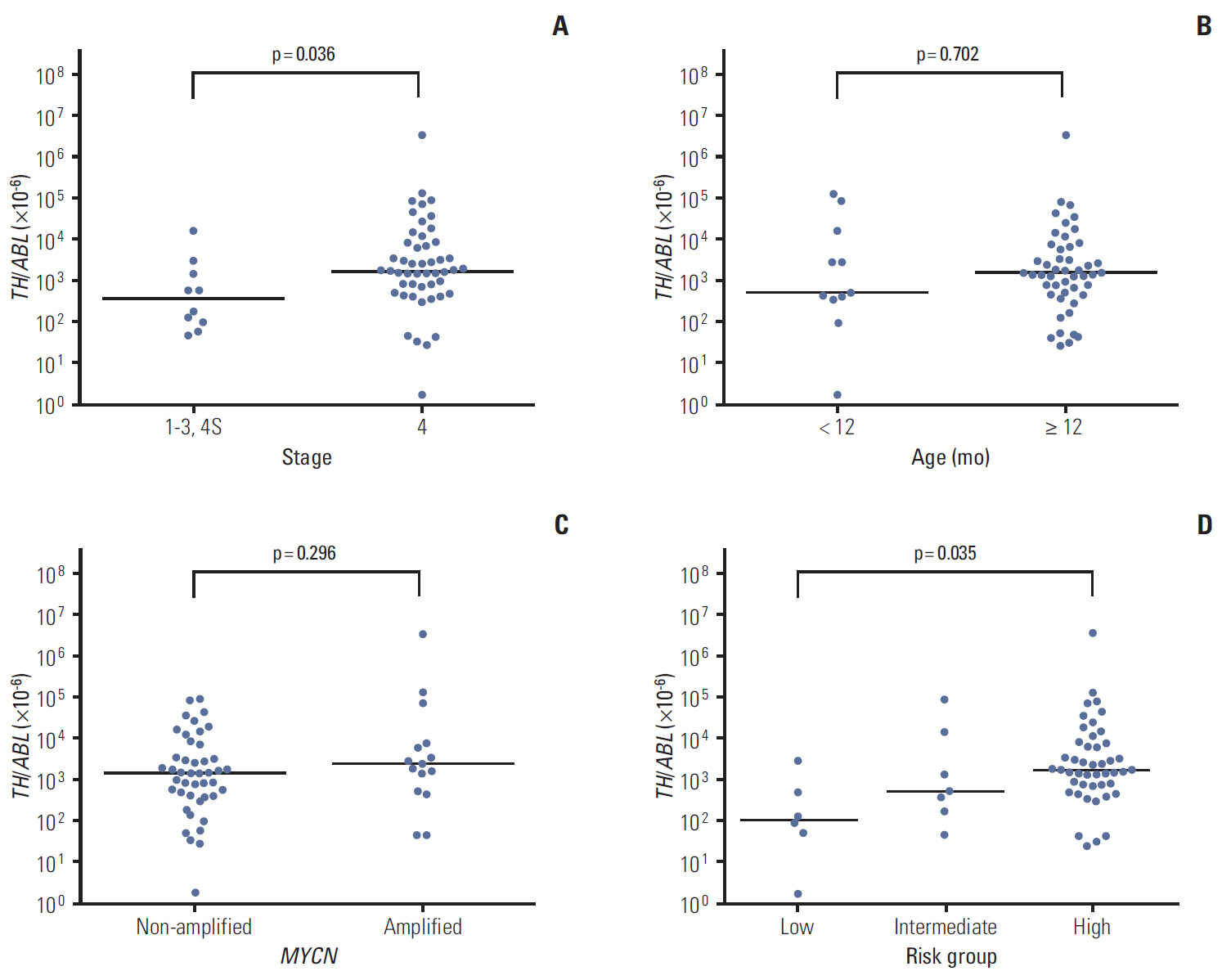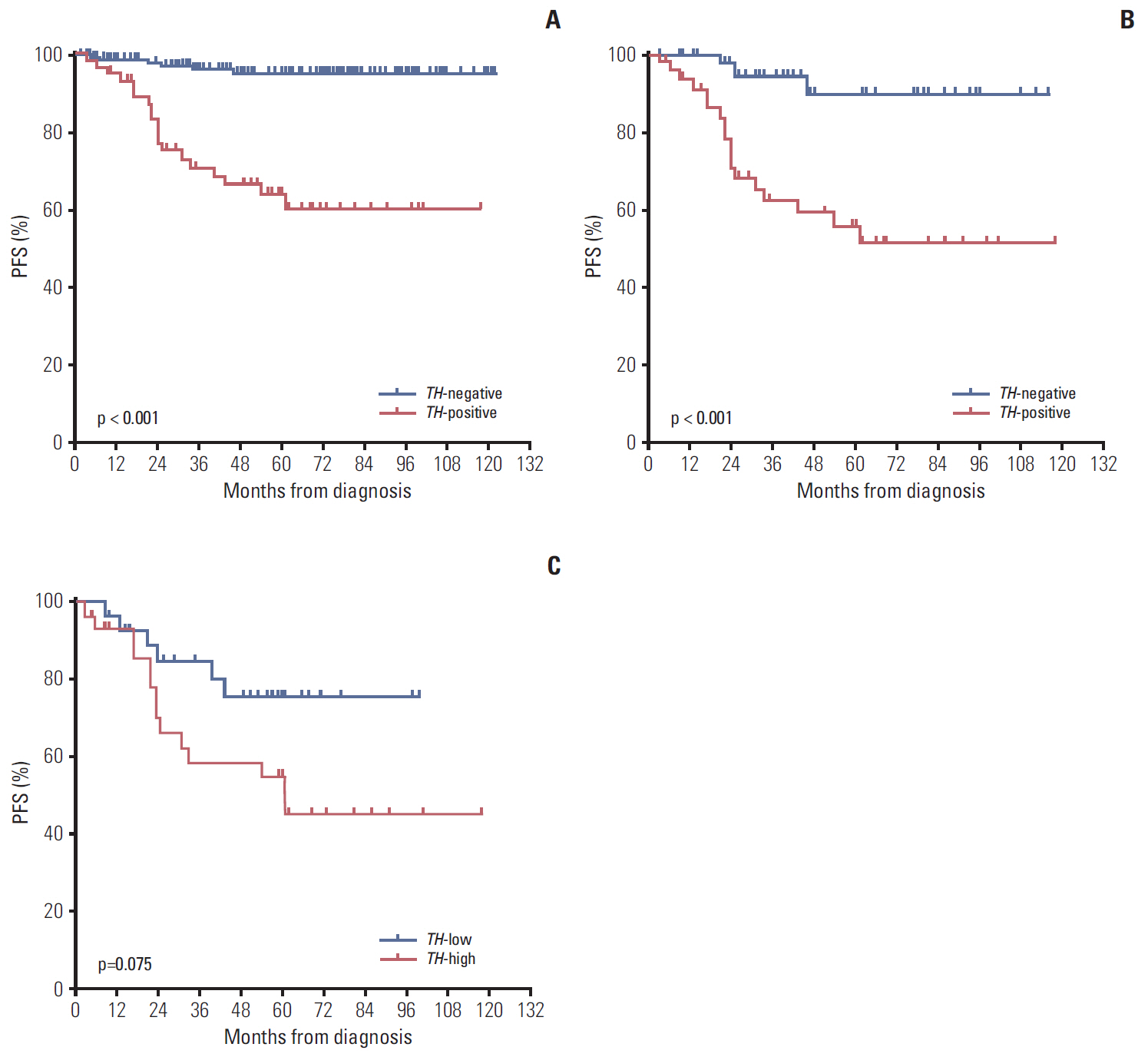Cancer Res Treat.
2016 Oct;48(4):1399-1407. 10.4143/crt.2015.481.
Clinical Significance of Tyrosine Hydroxylase mRNA Transcripts in Peripheral Blood at Diagnosis in Patients with Neuroblastoma
- Affiliations
-
- 1Department of Pediatrics, CHA Bundang Medical Center, CHA University, Seongnam, Korea.
- 2Princess Margaret Cancer Centre, University Health Network, Toronto, ON, Canada.
- 3Department of Pediatrics, Samsung Medical Center, Sungkyunkwan University School of Medicine, Seoul, Korea. kwsped@skku.edu
- KMID: 2356242
- DOI: http://doi.org/10.4143/crt.2015.481
Abstract
- PURPOSE
The purpose of this study is to investigate the clinical significance of tyrosine hydroxylase (TH) expression in peripheral blood (PB) at diagnosis in patients with neuroblastoma.
MATERIALS AND METHODS
TH mRNA expression in PB was measured by reverse transcription quantitative real-time polymerase chain reaction in 210 patients who were newly diagnosed with neuroblastoma from July 2005 to June 2015 and the clinical significance of TH expression in PB at diagnosis was evaluated.
RESULTS
TH expression was positive in 60 patients (28.6%). Fifty of 60 TH-positive patients had metastatic tumors and the remaining 10 had localized tumors. TH expression was associated with high-risk features (i.e., advanced stage, older age, unfavorable pathology, and MYCN amplification) at diagnosis. Among TH-positive patients, higher TH expression level was observed in high-risk patients than in low- or intermediate-risk patients (p=0.035). The probability of 5-year progression-free survival (PFS) was lower in TH-positive patients than in TH-negative patients (63.8±6.9% vs. 94.7±2.1%, p < 0.001). In analysis confined to high-risk patients, the 5-year probability of PFS remained lower in TH-positive patients (55.7±8.2% vs. 89.6±5.8%, p < 0.001). Among TH-positive patients, a higher expression level of TH was associated with a worse outcome. In multivariate analyses, positive TH expression in PB at diagnosis was an independent poor prognostic factor for PFS.
CONCLUSION
The treatment intensity should be tailored according to TH expression in PB at diagnosis.
MeSH Terms
Figure
Cited by 1 articles
-
Clinical Significance of Segmental Chromosomal Aberrations in Patients with Neuroblastoma: First Report in Korean Population
Hana Lim, Meong Hi Son, Ju Kyung Hyun, Hee Won Cho, Hee Young Ju, Ji Won Lee, Keon Hee Yoo, Ki Woong Sung, Hong Hoe Koo
J Korean Med Sci. 2020;35(14):e82. doi: 10.3346/jkms.2020.35.e82.
Reference
-
References
1. Shimada H, Ambros IM, Dehner LP, Hata J, Joshi VV, Roald B. Terminology and morphologic criteria of neuroblastic tumors: recommendations by the International Neuroblastoma Pathology Committee. Cancer. 1999; 86:349–63.2. Brossard J, Bernstein ML, Lemieux B. Neuroblastoma: an enigmatic disease. Br Med Bull. 1996; 52:787–801.
Article3. Fukuda M, Miyajima Y, Miyashita Y, Horibe K. Disease outcome may be predicted by molecular detection of minimal residual disease in bone marrow in advanced neuroblastoma: a pilot study. J Pediatr Hematol Oncol. 2001; 23:10–3.
Article4. Grima B, Lamouroux A, Boni C, Julien JF, Javoy-Agid F, Mallet J. A single human gene encoding multiple tyrosine hydroxylases with different predicted functional characteristics. Nature. 1987; 326:707–11.
Article5. Naito H, Kuzumaki N, Uchino J, Kobayashi R, Shikano T, Ishikawa Y, et al. Detection of tyrosine hydroxylase mRNA and minimal neuroblastoma cells by the reverse transcription-polymerase chain reaction. Eur J Cancer. 1991; 27:762–5.
Article6. Miyajima Y, Kato K, Numata S, Kudo K, Horibe K. Detection of neuroblastoma cells in bone marrow and peripheral blood at diagnosis by the reverse transcriptase-polymerase chain reaction for tyrosine hydroxylase mRNA. Cancer. 1995; 75:2757–61.
Article7. Kuroda T, Saeki M, Nakano M, Mizutani S. Clinical application of minimal residual neuroblastoma cell detection by reverse transcriptase-polymerase chain reaction. J Pediatr Surg. 1997; 32:69–72.
Article8. Burchill SA, Bradbury FM, Selby P, Lewis IJ. Early clinical evaluation of neuroblastoma cell detection by reverse transcriptase-polymerase chain reaction (RT-PCR) for tyrosine hydroxylase mRNA. Eur J Cancer. 1995; 31A:553–6.
Article9. Lee ST, Ki CS, Sung KW, Kim HJ, Kim JW, Kim SH, et al. Molecular detection of tyrosine hydroxylase in the peripheral blood of patients with neuroblastoma: useful at diagnosis but not predictive of subsequent relapse during off-therapy follow-up. Pediatr Hematol Oncol. 2011; 28:16–23.
Article10. Brodeur GM, Pritchard J, Berthold F, Carlsen NL, Castel V, Castelberry RP, et al. Revisions of the international criteria for neuroblastoma diagnosis, staging, and response to treatment. J Clin Oncol. 1993; 11:1466–77.
Article11. Peuchmaur M, d'Amore ES, Joshi VV, Hata J, Roald B, Dehner LP, et al. Revision of the International Neuroblastoma Pathology Classification: confirmation of favorable and unfavorable prognostic subsets in ganglioneuroblastoma, nodular. Cancer. 2003; 98:2274–81.12. Sung KW, Lee SH, Yoo KH, Jung HL, Cho EJ, Koo HH, et al. Tandem high-dose chemotherapy and autologous stem cell rescue in patients over 1 year of age with stage 4 neuroblastoma. Bone Marrow Transplant. 2007; 40:37–45.
Article13. Burchill SA, Lewis IJ, Abrams KR, Riley R, Imeson J, Pearson AD, et al. Circulating neuroblastoma cells detected by reverse transcriptase polymerase chain reaction for tyrosine hydroxylase mRNA are an independent poor prognostic indicator in stage 4 neuroblastoma in children over 1 year. J Clin Oncol. 2001; 19:1795–801.
Article14. Oltra S, Martinez F, Orellana C, Grau E, Fernandez JM, Canete A, et al. The doublecortin gene, a new molecular marker to detect minimal residual disease in neuroblastoma. Diagn Mol Pathol. 2005; 14:53–7.
Article15. Stutterheim J, Gerritsen A, Zappeij-Kannegieter L, Kleijn I, Dee R, Hooft L, et al. PHOX2B is a novel and specific marker for minimal residual disease testing in neuroblastoma. J Clin Oncol. 2008; 26:5443–9.
Article16. Bozzi F, Luksch R, Collini P, Gambirasio F, Barzano E, Polastri D, et al. Molecular detection of dopamine decarboxylase expression by means of reverse transcriptase and polymerase chain reaction in bone marrow and peripheral blood: utility as a tumor marker for neuroblastoma. Diagn Mol Pathol. 2004; 13:135–43.17. Cheung IY, Vickers A, Cheung NK. Sialyltransferase STX (ST8SiaII): a novel molecular marker of metastatic neuroblastoma. Int J Cancer. 2006; 119:152–6.
Article18. Viprey VF, Lastowska MA, Corrias MV, Swerts K, Jackson MS, Burchill SA. Minimal disease monitoring by QRT-PCR: guidelines for identification and systematic validation of molecular markers prior to evaluation in prospective clinical trials. J Pathol. 2008; 216:245–52.
Article19. Corrias MV, Haupt R, Carlini B, Cappelli E, Giardino S, Tripodi G, et al. Multiple target molecular monitoring of bone marrow and peripheral blood samples from patients with localized neuroblastoma and healthy donors. Pediatr Blood Cancer. 2012; 58:43–9.
Article20. Gilbert J, Norris MD, Marshall GM, Haber M. Low specificity of PGP9.5 expression for detection of micrometastatic neuroblastoma. Br J Cancer. 1997; 75:1779–81.
Article21. Trager C, Vernby A, Kullman A, Ora I, Kogner P, Kagedal B. mRNAs of tyrosine hydroxylase and dopa decarboxylase but not of GD2 synthase are specific for neuroblastoma minimal disease and predicts outcome for children with high-risk disease when measured at diagnosis. Int J Cancer. 2008; 123:2849–55.22. Viprey VF, Gregory WM, Corrias MV, Tchirkov A, Swerts K, Vicha A, et al. Neuroblastoma mRNAs predict outcome in children with stage 4 neuroblastoma: a European HR-NBL1/SIOPEN study. J Clin Oncol. 2014; 32:1074–83.
Article23. Yanez Y, Grau E, Oltra S, Canete A, Martinez F, Orellana C, et al. Minimal disease detection in peripheral blood and bone marrow from patients with non-metastatic neuroblastoma. J Cancer Res Clin Oncol. 2011; 137:1263–72.
Article24. Burchill SA. Micrometastases in neuroblastoma: are they clinically important? J Clin Pathol. 2004; 57:14–20.
Article25. Yanez Y, Hervas D, Grau E, Oltra S, Perez G, Palanca S, et al. TH and DCX mRNAs in peripheral blood and bone marrow predict outcome in metastatic neuroblastoma patients. J Cancer Res Clin Oncol. 2016; 142:573–80.
Article
- Full Text Links
- Actions
-
Cited
- CITED
-
- Close
- Share
- Similar articles
-
- Sensitive Detection of Minimal Residual Neuroblastoma Cells Using RT-PCR for Tyrosine Hydroxylase mRNA
- A Comparative Analysis between Flow Cytometry and RT-PCR Methods for the Detection of Minimal Residual Disease in Neuroblastoma
- High Dose Chemotherapy and Autologous Peripheral Blood Stem Cell Transplantation in Pediatric Patients with High-risk Neuroblastoma
- Alteration of Alk in Neuroblastoma
- Palliative effect of (131)I-MIBG in relapsed neuroblastoma after autologous peripheral blood stem cell transplantation



